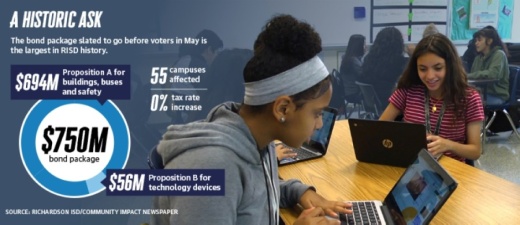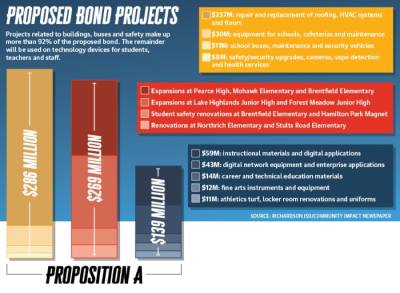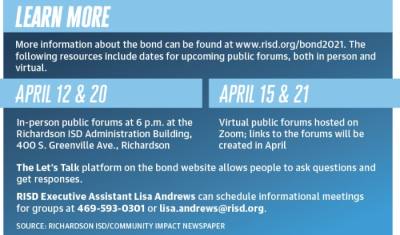Jacob, who served on the district’s 2021 bond steering committee, said he believes the measures would provide “equity across the board” for all students.
“We are making a concerted investment in our schools, in our leadership and especially in the future of our students,” he said. “We did not go into this process lightly.”
A recent facilities audit of RISD’s campuses found the district’s buildings to be 53 years old on average. The age of many of those buildings has created challenges for educators, as instruction is delivered very differently today than it was in the 1950s and 1960s, Assistant Superintendent Sandra Hayes said.
“At some point, renovating stops being an effective manner for fixing schools,” Hayes said. “We need different kinds of spaces.”
To address those needs and tackle projects ranging in focus from technology to safety, the RISD board of trustees called the $750 million bond for the May 1 election. While that bond package is the largest in district history, Superintendent Jeannie Stone said it has the potential to have “huge impacts for generations to come,” in part because of how it would move sixth-graders to junior high campuses.
“This allows for us to free up the space [for pre-K classes] by this transition to [a] middle school [model],” Stone said.
The bond package includes two separate propositions. Proposition A totals $694 million and would cover infrastructure and safety projects, construction and renovation plans, and projects to support teachers and students. Proposition B totals $56 million and would cover updates to district technology devices.
RISD has brought a bond package before voters every five years since 1996. Each of the five previous bonds have been approved by voters; the most recent, in 2016, received nearly 67% support. That $437.1 million bond package was the largest in district history at the time.
Planned projects
Nearly $300 million of the proposed bond funds in Proposition A have been earmarked for upgrades related to district infrastructure and security, such as repair and replacement of floor, roofing, and heating, ventilation and air conditioning systems.
More than $250 million from the proposition is set aside for construction and renovation projects, including additions at J.J. Pearce High School, Mohawk Elementary School and Brentfield Elementary School. Another $140 million from the proposition is earmarked for teaching and student support, including $59 million for instructional materials and teaching apps.
Deputy Superintendent Tabitha Branum said the bond has a strong instructional component.
“Without bonds, we wouldn’t be able to necessarily provide [certain things, such as graphing calculators and microscopes,] at the same level that we do now,” Branum said.
Middle school transformation
Using a phased construction approach, the middle school transformation plan calls for facility adjustments at junior high campuses over the course of several years to make room for sixth-graders. The goal is to have construction completed at all campuses by school year 2030-31.
Lake Highlands and Forest Meadow junior highs would be the first schools addressed: The former would be completely rebuilt and the latter thoroughly renovated. Lake Highlands scored the worst on the district’s facilities audit, according to Hayes. Stone said the school has “reached the end of its useful life.”
Branum said discussion of the middle school transformation dates back to 2019, when the district formed a committee that studied RISD’s current junior high model and compared it to the middle school model used by 95% of Texas school districts. One of the reasons for recommending a traditional middle school model, Branum said, is because Texas curriculum is built for it.
“The materials and the resources are designed with the understanding that sixth grade sits and lives in the middle school,” she said.
Another reason for the recommendation is that sixth-graders would receive more social and emotional support in middle schools, she said.
“While we know that, sometimes, our elementary parents fear their sixth-graders moving to middle school, there was a strong belief that giving our students one more year in a middle school model at that really critical transition time during [their] adolescence, ... was critical,” Branum said.
The middle school model would also benefit the district’s fine arts and athletics programs, she said. Under the current configuration, teachers have to travel between schools to offer programs, such as band, to sixth-graders, Branum said.
“Our elementaries were not designed for that,” Branum said.
Projects at the district’s remaining six junior highs are expected to be included in the 2026 bond.
“We believe at this point that we should be able to afford very close to another $750 million in 2026,” Chief Financial Officer David Pate said. “But there are certainly many variables at play in that analysis.”
No tax rate increase
The portion of RISD’s tax rate put toward paying off the district’s accrued debts is $0.35 per $100 of taxable property value. If the bond is approved, Pate said that rate should be enough for the district to add another $750 million in debt over the next five years without increasing the tax rate.
“We will not be issuing all $750 million at once,” Pate said. “We will issue [it] in portions over the next five years.”
The expected growth of property values in the district also plays a role in RISD not needing to increase its tax rate, Pate said. RISD has averaged 3.7% annual property value growth over the last 25 years, he added.
“With the effect of COVID on the economy, we were very conservative in our property tax growth assumptions,” Pate said. “It was 2.5% for this upcoming year and then 1% value growth every year thereafter.”
Although RISD is not planning to change its tax rate, voters could still see an increase in their tax bills if their property values were to go up. However, because of recent state legislation, language on the ballot must state “This is a property tax increase,” which was not a requirement for any of RISD’s previous bond packages.
If only one of the propositions were approved, Hayes said funds from that proposition could not be used for projects in the failed proposition.
If neither proposition is passed, Pate said district staff would likely discuss the possibility of calling another bond election for November. The district and the board of trustees could also look into covering bond expenditures through RISD’s operating funds. However, that would not include the middle school transformation plan, Stone said.
“It couldn’t be funded [separately from the bond],” Stone said. “The vast majority of the projects that are part of the package could not and would not be funded [without the bond].”







